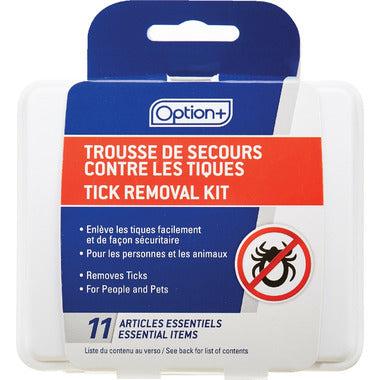Option+
Option+ Tick Removal Kit
Option+ Tick Removal Kit
Couldn't load pickup availability
The Option+ Tick Removal Kit is designed to safely and effectively remove ticks from both humans and pets.
Features (possible based on common tick removal kits):
-
Tick removal tools: Likely includes a variety of tools to address different tick sizes and locations. This may include:
- Tick removal spoon: A spoon-shaped tool that slides under the tick's body to remove it without squeezing and potentially bursting its insides.
- Fine-pointed tweezers: Useful for grabbing and removing small ticks or nymphs.
-
Antiseptic wipes: Used to clean the bite area before and after tick removal to reduce the risk of infection.
-
Specimen container: May be included to store the removed tick for testing if needed (consult a doctor for guidance).
-
Magnifying glass (optional): Might be included to help see small ticks more clearly during removal.
Benefits:
- Safe and effective tick removal for both people and pets (consult a veterinarian for pet use).
- Reduces the risk of infection by allowing for clean tick removal.
- Portable and convenient for outdoor activities or travel to tick-infested areas.
How to Use (General guidelines, refer to specific instructions on the kit):
- Identify the tick: If possible, identify the type of tick to assess potential disease risks.
- Choose the appropriate tool: Select the tool best suited for the tick's size and location.
- Gently grasp the tick: Using the tool, carefully grasp the tick as close to the skin surface as possible.
- Apply steady, upward pressure: Pull the tick straight out with slow, even pressure. Avoid twisting or squeezing the tick's body.
- Clean the bite area: Once removed, clean the bite area with an antiseptic wipe included in the kit.
- Dispose of the tick: Properly dispose of the removed tick in a sealed container or by crushing it with a tissue.
- Monitor the bite area for signs of infection like redness, swelling, or pus. Consult a doctor if you experience any concerning symptoms.
Safety Information:
- Follow the instructions on the kit carefully.
- Do not squeeze or crush the tick's body, as this can increase the risk of infection.
- If the tick's mouthparts remain attached to the skin, don't try to remove them with tweezers. Leave them alone and they will eventually fall off on their own.
- Consult a doctor if you are unable to remove the entire tick, have difficulty removing it, or experience any concerning symptoms after a tick bite.
Disclaimer:
This information is intended for educational purposes only and is not a substitute for medical advice. Always consult with a doctor if you have concerns about tick bites or proper tick removal techniques.
Share


